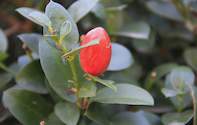The num num is a spiky-stemmed, glossy leaf shrub with fragrant white star-shaped flowers and sweet tasting red fruit and is native to the coastal regions of the KwaZulu-Natal province of South Africa.

The Carissa macrocarpa, is also called the Natal plum, big num-num, grootnoemnoem (Afr.) or amatungulu (Zulu) while its smaller relative Carissa bispinosa is also known as the East African num num. C. bispinosa is a smaller, lower growing plant but with equally tasty, smaller fruit.
The Arabian num num (C. edulis) also produces small sweet fruit. Carissa comes from the Indian name for plants of this genus, containing a bitter and poisonous substance in the bark called carrisin. ‘Bispinosa’ means two-spined and refers to the the forked spines of the plants.
‘Num num’ probably refers to the sound of pleasure when eating the tasty little fruits. Num nums were introduced to America in the 1880’s where it is still a popular ornamental plant in California and Florida. It was later introduced to other countries such as Israel, Puerto Rico, the Philippines and India.
Num num fruit is oval and can range in size from 1,5 to 5 cm depending on the variety. Its fleshy fruit ripens to red and can be picked from March to October. When picked and sliced, the fruit exudes a white sticky latex (’milk’). Num num fruit is rich in vitamin C, calcium (Ca), magnesium (Mg) and phosphorus (P) and high in pectin which will help to set low-pectin jams like strawberry.
The soft seeds are edible and need not to be discarded. The plant’s leaves are popular with kudus while monkeys and certain birds enjoy the fruit. Traditional uses of the num num include eating the fresh fruit, but also for the preparation of jams and jellies.
The roots are used to treat toothache while the Swazi people uses the num num in a traditional ceremony in which it is fed to a bull to increase its aggression before it is killed by Swazi warriors.
Modern uses are mostly culinary. Num nums are delicious when combined with baked quince or pear, it adds a tartness to chutneys and onion marmalades and can be cooked and dried slightly before being baked into muffins. The num num is easily grown from seeds, cuttings or layering (layering is when a stem forms roots while still attached to the mother plant).
Seeds can be soaked in warm water to speed up the germination process. Num nums might only start producing fruit after two years. The evergreen water-wise plant forms dense bushes and is found in bushveld, coastal or forested regions of all provinces in South Africa except the arid Northern Cape.
Fast growing num nums make good ornamental plants or can be planted 1 m apart to form hedges, but should be kept pruned to stay in shape. They prefer light, well-drained soil with lots of compost and can either grow in full sun or semi-shade.
Num nums are relatively drought resistant and can withstand seabreezes and salty air, but is sensitive to severe frost and cold winters. It is often used in public spaces such as road barriers and parking areas. The num num is also a very popular bonsai tree.
Medical Disclaimer
Information is for educational and informational purposes only and may not be construed as medical advice. The information is not intended to replace medical advice or treatment offered by healthcare professionals.By Marinda Louw